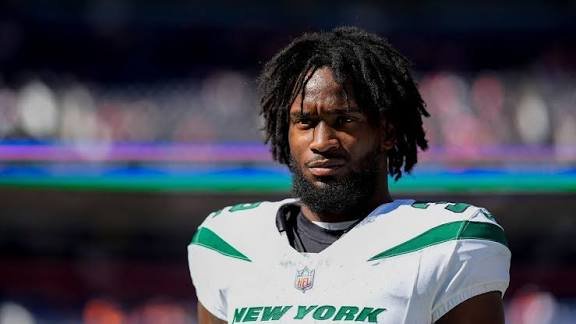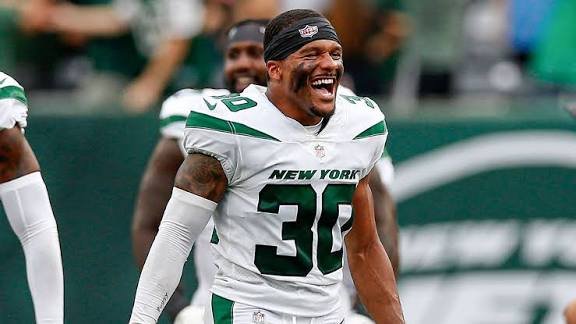
Introduction

Michael Carter is a name increasingly familiar to fans of the NFL and fantasy football alike. With a unique combination of elusiveness, receiving skill, and a compact frame, Carter has carved out a niche as a rotational running back and pass-catching threat. In this detailed profile, we’ll explore his NFL statistics, fantasy outlook, physical attributes (height, weight, measurables), draft background, strengths and weaknesses, and what to expect from him moving forward.
Early Life & College Career
Michael Carter played his collegiate football at the University of North Carolina (UNC). Before entering the draft, he formed a dynamic rushing tandem with Javonte Williams — a pairing that drew major NFL attention.
College Performance & Skill Set
-
In 2019, Carter rushed for 1,003 yards on 177 attempts, averaging about 5.7 yards per carry, and added multiple receiving contributions.
-
In 2020, Carter’s productivity increased, showcasing his dual-threat ability.
-
He was praised for his vision, agility, receiving ability out of the backfield, and ability to make defenders miss in space — though scouts noted limitations in size and contact balance.
Because of his receiving prowess and elusiveness, Carter was often viewed as more of a third-down or change-of-pace back than a pure every-down workhorse.
Draft Pick & NFL Entry
Carter entered the NFL in the 2021 draft, where he was selected in Round 4, pick #107 overall.
At the time of the draft, his measurable profile included:
-
Height: about 5 ft 8 in (5’7 7/8″ formally)
-
Weight: ~ 201 lbs
-
Arm length, wingspan, hand size metrics: e.g. arms ~29 1/8″, wingspan ~73½″, hand ~9″
-
At his pro day or combine equivalents, he posted agility drills, 40-yard dash times, etc., that reinforced his strength in quickness rather than straight-line speed.
Viewed as a versatile, shiftier back with receiving upside, Carter entered the league with expectations to carve a role rather than dominate volume from the start.
Physical Attributes & Measurables
Here is a more complete breakdown of Carter’s size and athletic traits:
-
Height: ~ 5 ft 8 in (5’7 7/8″)
-
Weight: ~ 201 lbs
-
Arm length: ~ 29 1/8 in
-
Wingspan: ~ 73 1/2 in
-
Hand size: ~ 9 in
-
Athletic tests / drills:
-
He ran his drills in the range that showed solid agility and burst (though not elite 40-yard dash times compared to feature backs).
-
His strength in quick cuts, lateral movement, and short-area explosion was regarded as a key part of his appeal.
-
These measurables underscore Carter’s identity as a lower-profile but technically proficient back — one dependent on scheme, opportunity, and usage rather than pure size or power dominance. Michael Carter NFL stats.
NFL Statistics & Performance (Through Recent Seasons)
To evaluate Carter’s performance to date, we look at his NFL stats, usage trends, and snap share history.
Season-by-Season Summary
From sources such as Pro Football Reference and PlayerProfiler, the following snapshot is available:
-
2021 (rookie year): Carter saw limited usage, as befits a mid-round pick stepping into a roster with more established backs.
-
2022–2023: Gradual increases in situational usage, especially as a receiver out of the backfield, though still not a primary back.
-
2024 season: Played in 3 games, recorded 35 carries for 131 rushing yards (~3.7 yards per carry) plus 11 receptions for 57 receiving yards and 1 touchdown.
-
2025 (so far): Limited in early opportunities; the depth chart ahead of him has constrained volume.
From PlayerProfiler and analytics sources:
-
In years when he has touches, Carter has demonstrated explosive ability — his Explosive Play Rating (EPX) indicates that when he gets into space, he can generate highly productive runs or receptions.
-
However, his opportunity share (percentage of team carries + targets) tends to rank low compared to lead backs.
-
In limited samples, some metrics such as yards created per touch and breakaway runs show promise, but volume and consistency remain concerns.
-
His receiving route participation and target share remain modest when on the field.
Snap Share & Depth Chart Placement
-
In many games, Carter’s snap share is low, consistent with a rotational or change-of-pace role.
-
He often competes behind primary backs and is employed in passing-down situations or in relief during injuries.
-
For the 2025 season, with injuries in the Cardinals’ backfield, Carter has been elevated from the practice squad and could see more opportunity. Michael Carter NFL stats.
Fantasy Football Outlook
For fantasy football managers, analyzing Carter’s potential involves balancing his talent, usage likelihood, team situation, and volatility risk.
Current Fantasy Landscape & Projections
-
As of 2025, Carter is not typically drafted early; his ADP (average draft position) is very low, reflecting his backup / depth status.
-
FantasyPros currently lists some modest projections when he is active — e.g. ~ 6.3 points in some weeks, assuming a few touches and receiving volume.
-
His ranking in many consensus lists is mid-range among running backs, especially in deeper formats or PPR (points per reception) formats.
Fantasy Value Drivers & Upside
-
Receiving ability is his biggest edge in fantasy: Carter can be more consistent in target share, especially on passing downs.
-
Explosiveness in limited touches can lead to big scoring plays which boost fantasy upside relative to volume.
-
Injury and depth chart volatility create upside: if injuries occur to lead backs, Carter could briefly assume a higher role.
Risks & Limitations
-
He will rarely get enough volume to be a safe RB1 in standard formats — consistent floor is limited.
-
Efficiency may suffer if his touches increase beyond niche usage.
-
Being behind other backs on the roster (who may be more physically imposing or preferred in rush-heavy schemes) is a constant roadblock.
Best Use in Fantasy Leagues
-
Bench / FLEX stash in deeper leagues or PPR formats
-
Handcuff or depth piece for teams with weak depth at running back
-
High-upside lottery ticket in matchups where the opponent is weak versus receiving backs
In summary: Carter is not a high-floor pick, but he can pay off in favorable situations or as an injury fills the vacancy ahead of him. Michael Carter NFL stats.
Strengths & Weaknesses
Strengths
-
Agility / Elusiveness: Carter is adept at making defenders miss in open space, and his lateral quickness is above average.
-
Receiving skills: He is a reliable option out of the backfield, able to catch and gain separation.
-
Vision and patience: He shows good decision-making in choosing lanes and adjusting to blocking schemes.
-
Versatility: His profile makes him valuable as a rotational or passing-down back.
Weaknesses
-
Size / contact durability: At 5’8″ and 201 lbs, he is vulnerable to being overpowered or tackled behind the line.
-
Limited upside in volume roles: He is less effective when tasked with heavy every-down rushing loads.
-
Blocking / pass protection concerns: His smaller frame limits his ability to reliably block big linebackers or blitzers.
-
Depth chart competition: He often battles for touches behind physically stronger backs who may be favored for rushing downs. Michael Carter NFL stats.
What to Expect Going Forward & Projections
As Carter’s NFL career continues, a few pathways are plausible:
-
Situational contributor / third-down specialist: This is likely his baseline role — being used in passing downs, change-of-pace situations, and as a backup.
-
Injury-driven opportunity: When injuries strike the backfield, Carter may get temporary elevation and chance to prove himself.
-
Breakout if usage increases: If an offense leans more pass-heavy or values receiving backs heavily, Carter could see elevated value — though this remains less likely than a rotational role.
-
Long-term depth / mentor role: As he ages and with younger backs coming up, he may settle into a depth role, contributing in niche packages.
In fantasy terms, managers should monitor weekly usage, injury news, and snap counts — Carter’s upside will depend substantially on opportunity more than latent talent. The seasons where he has modest volume may be the ceiling in many years unless he earns a larger role. Michael Carter NFL stats.
Summary & Key Takeaways
-
Michael Carter is a compact, agile, receiving-capable running back whose collegiate success translated into a mid-round NFL pick (4th round, #107).
-
His size (~ 5′8″, 201 lbs) and athletic traits emphasize agility and receiving skill over brute power.
-
His NFL stats to date show limited volume but flashes of explosiveness when used.
-
In fantasy football, Carter’s value is best as a depth piece, FLEX option, or late flier — leveraging his pass-catching ability and upside in favorable matchups.
-
The key to unlocking value is opportunity: injuries ahead of him or scheme shifts could temporarily lift him into more meaningful roles.
FAQs (Frequently Asked Questions)
Q1: What is Michael Carter’s height and weight?
A: He is approximately 5 feet 8 inches tall (~5’7 7/8″) and weighs about 201 pounds.
Q2: Which team drafted Michael Carter, and when?
A: Michael Carter was drafted in the 4th round, 107th overall, in the 2021 NFL Draft. Michael Carter NFL stats.
Q3: What are Michael Carter’s career NFL stats?
A: As of the 2024 season, Carter has recorded 35 rushing attempts for 131 yards (~3.7 YPC), along with 11 receptions for 57 receiving yards and 1 touchdown. His limited usage in other years means totals remain modest.
Q4: What is Michael Carter’s fantasy outlook?
A: Carter is best viewed as a depth/flex option, particularly in PPR formats. His upside comes from his pass-catching ability and potential to produce explosively when given touches. He is unlikely to be a consistent RB1 due to limited volume.
Q5: What are the strengths and weaknesses of his game?
A:
-
Strengths: agility, elusiveness, receiving skills, vision, versatility
-
Weaknesses: limited size / contact durability, blocking pass protection, inability (so far) to handle heavy rushing loads, depth chart competition
Q6: Could Michael Carter become a feature back in the NFL?
A: It is possible but unlikely under most current circumstances. For him to become a true feature back, he would need consistent volume, improved durability, and a scheme built around his strengths. More likely, he remains a valuable rotational or passing-down back.
